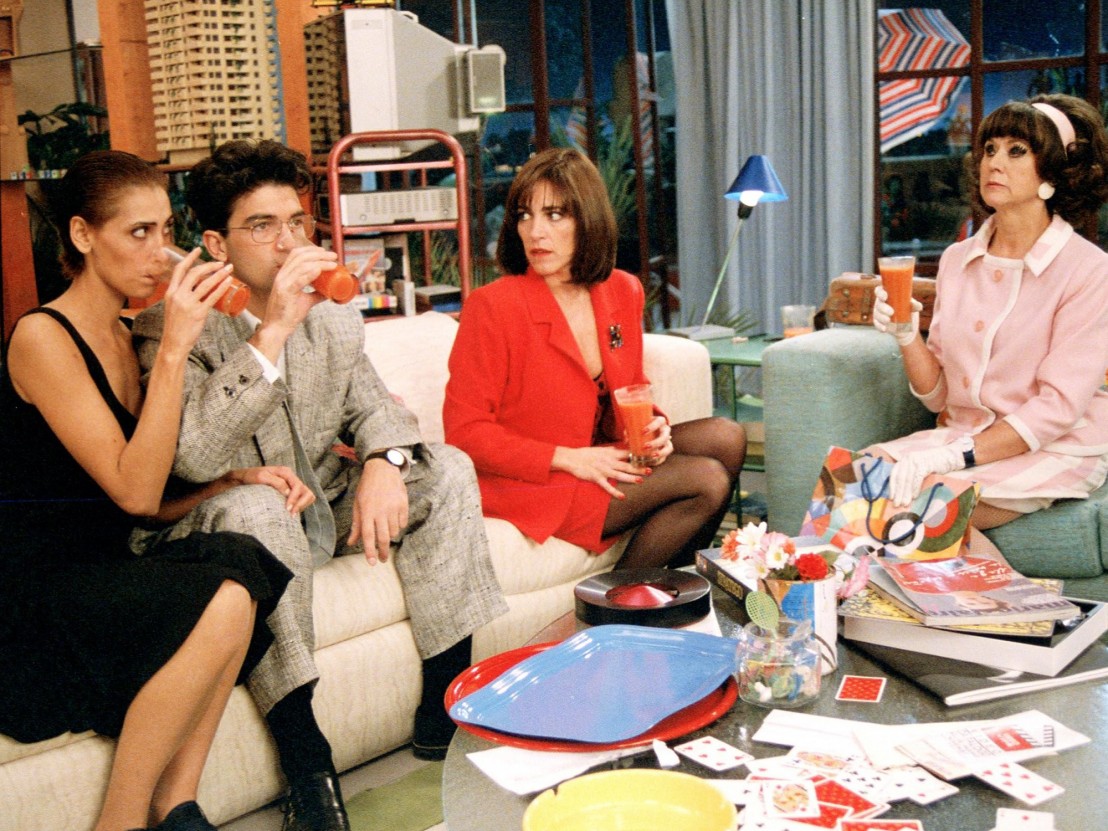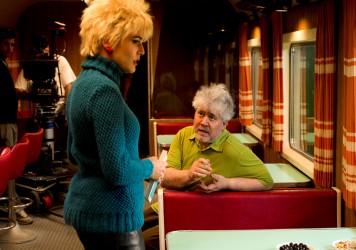
Why are Candela’s earrings shaped like little Italian espresso makers? It’s a question that brings me back, again and again, to Pedro Almodóvar’s unimpeachable 1988 film, Women on the Verge of a Nervous Breakdown. At the core of that question lies the genius of this eccentric and beloved Spanish filmmaker. Those earrings are probably not the reason why the film became an international hit upon its release, courting the attention of the Academy a full decade before All About My Mother won Best Foreign Language Film at the 2000 Oscars. Those earrings are symbolic of the colourful and frenzied cinematic universe that Almodóvar been building now for close to 40 years.
He’s still building – his latest, Julieta, has already proven a hit with critics in Spain. Every new Almodóvar film is an occasion to marvel at his brilliance, not least as a fantastic writer as he so often finds the perfect balance between suspense, laughter and tears. An Almodóvar film is also a singular visual experience, packed with references but also wholly authentic in its disorganised arrangement. And, of course, he has earned our admiration by introducing us to some of cinema’s finest actresses: Penélope Cruz, Victoria Abril, Rossy de Palma, Marisa Paredes and Carmen Maura.
He has covered a broad range of subjects: transsexuality in High Heels and All About My Mother; love and loss in Talk to Her and The Flower of My Secret; diabolical revenge in The Skin I Live In; mother-daughter relations in Volver; and abandonment in his forthcoming Julieta. His 2013 comedy I’m So Excited seems to exist as an outlier, yet Almodóvar started out with this kind of madcap comedy, in films like Law of Desire and Pepi, Luci, Bom. Women on the Verge of a Nervous Breakdown is the film where Almodóvar manages to draw upon almost all of his pet themes at the same time. He puts everything into the pot and comes out with a film that’s light, refreshing and tangy.
It’s about women who are caused to suffer by men and the ways – comic and tragic – in which they vent their anger. After their break-up, Pepa (Carmen Maura) needs to talk to Ivan about something important before he goes off on a trip with another woman. For every sub-plot, there’s a woman with a tacit connection to the former couple. Pepa’s protégée, Candela (Maria Barranco), provided lodging to the Shiite terrorists who planned to hijack Ivan’s plane to Stockholm. His ex-wife, Lucia (Julieta Serrano), also tries to reach him to make him pay for the years she spent in an insane asylum. Ivan’s son (Antonio Banderas) is under the influence of his rough virgin fiancée (Rossy de Palma). Finally there’s Paulina, a feminist lawyer whose shadow looms large over the characters until we discover she, too, might be on the verge of full collapse.
The film opens on a clearly fake scale model of the building Pepa lives in, her voiceover announcing that she can’t save her relationship. So what’s the point of this story? Is it just so Almodóvar can play with his characters like pieces of Lego? Add to this the kitschy-vintage 1950s-style set and it becomes easy to allow the stories to intertwine naturally upon first viewing. But kooky coincidences aren’t so kooky or coincidental in real life, are they?
For me, the first viewing was pure entertainment. The second was a revelation. All the details I thought were part of the eclectic mess suddenly became clues that had been left for the viewer to find. The film builds up a certain mood which hints at (without revealing) what’s going to happen next. From the model to the fake view of the Madrid skyline visible from Pepa’s terrace, everything is designed to make you aware that this is only cinema.
But just because you know it’s cinema, doesn’t mean you can’t be surprised by what you see. Characters’ states of mind are exaggerated, there are clichés everywhere and references to Hitchcock are all too easy to spot. All this makes the film timeless. Almodóvar plays with the paradox between the artificial appearance of the movie and the feelings we experience while watching it. Of course, fooling the audience like this isn’t enough to ensure your status as a visionary director. The film’s mid-century references would have little impact without the accompanying image of women that is both progressive and ironically old fashioned.
On one hand you have a striking title which reminds you of a women’s disease of yesteryear, invented by men to justify their sexual frustration – hysteria. On the other hand, the whole point of the movie is that desperately waiting for a phone call and not being able to regain control of your life after a bad break-up doesn’t make you weak. Carmen Maura’s performance perfectly demonstrates that being on the verge of a nervous breakdown isn’t the same as fully freaking out.
At one point, a taxi driver who constantly crosses Pepa’s path pronounces this unfortunate sentence: “A lady’s no dangerous if you know how to handle her.” Almodóvar knows how to handle his actresses, he knows how to reveal both their inner and exterior beauty. But the moral of the film seems to go against the taxi driver’s assertion: women can handle it alone, especially if they’re wearing large novelty earrings.
Published 30 Mar 2016

Pedro Almodóvar’s latest is an intoxicating elixir of dark fantasy, sick obsession and all-consuming desire.

The legendary Spanish filmmaker throws open the doors of his Madrid work space to the hungry eyes of LWLies.

If you trust trailers, then this one confirms that Spain’s finest director has returned to doing what he does best.